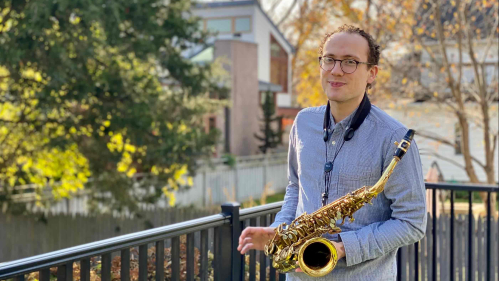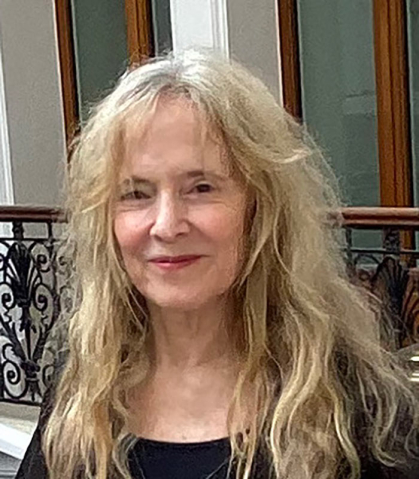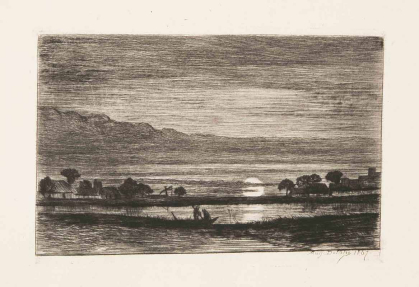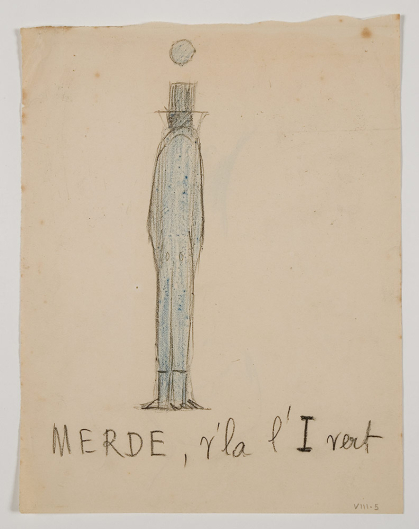Zimmerli Event Features Poetry by Former Rutgers Professor – and Music by Her Son’s Jazz Quartet

Mary Shaw, who taught French at the School of Arts and Sciences, will read from her original work accompanied by Mason Gross alum Pierre Cornilliat and his band
A forthcoming event at the Zimmerli Art Museum is a mother and son collaboration featuring poetry, live music, artmaking and meaningful connections to Rutgers.

The December edition of SparkNight, a free monthly art party at the Zimmerli Art Museum, includes a multimedia performance involving Mary Shaw, a Rutgers professor emerita of French, and her son’s jazz group, the Pierre Cornilliat Quartet. SparkNight is set from 4:30 p.m. to 8 p.m. Thursday, Dec. 7, at 71 Hamilton St., New Brunswick. Admission to the event, which includes complimentary light refreshments, is free.
Pierre Cornilliat, a saxophonist who graduated from the Mason Gross School of the Arts in 2020 with a bachelor of music degree in jazz studies, and his group will perform from 5 p.m. to 5:30 p.m. and from 7 p.m. to 7:30 p.m.
“We are freelance artists who have performed throughout New Jersey and New York City,” said Cornilliat, adding he has performed with celebrated jazz drummer Winard Harper at Moore’s Lounge in Jersey City.
In addition to playing a selection of jazz standards and bebop tunes, Cornilliat’s band will accompany a recording of his mother’s “Quartet,” a narrative poem read by her and three others.
“The music is partially composed by me, partially improvised by the group,” he said.

“Moonrise,” an 1867 etching on paper by Auguste-Marie Delâtre, is part of the Zimmerli Art Museum’s collection at Rutgers.
This multimedia performance – featuring original poetry read by Shaw, images from the Zimmerli’s collection of 19th-century French art and music from the jazz quartet – is set from 5:30 p.m. to 6:45 p.m. Attendees are encouraged to make their own shadow puppets from 5 p.m. to 7 p.m. Materials will be provided.
Assisting Shaw is Alfredo Franco, a faculty member of the Rutgers Writers House who teaches advanced fiction and introduction to creative writing. Franco, the former head of education at the Zimmerli, lent his recorded voice as part of the multimedia “Quartet” performance and will join Shaw in a live reading of her poetry collection, Rhymes.
“I send my students to the Zimmerli all the time to work on ekphrastic exercises using the collections,” said Franco, a graduate of Johns Hopkins University and the master of fine arts program at New York University whose work has appeared in multiple literary journals.
Shaw, who came to Rutgers in 1987 after completing her doctor of philosophy degree at Columbia University, discussed her poetry and her longtime connection to the Zimmerli.
What is your connection to the Zimmerli?
Soon after I arrived at Rutgers, I was introduced to the Zimmerli's exceptionally rich fin-de-siècle French rare books and graphic arts collection by the museum's former director, Phillip Dennis Cate. He knew I was a scholar of the period interested in relationships among the arts and a specialist of one of Europe's greatest modern poets, Stéphane Mallarmé, some of whose works figure prominently in the Zimmerli's holdings.
I was deeply impressed and surprised by the richness of the Zimmerli's French collections and began to do research and teach regularly there, most recently in collaboration with Christine Giviskos, the curator of prints, drawings and European art.
I also co-edited one of the Zimmerli's catalogs, The Spirit of Montmartre: Cabarets, Humor, and the Avant-Garde (1875-1905), in 1996, and have co-organized multiple conferences and other projects.

What initially drew you to French language, literature and culture?
Modern French poetry and theater have always been my principal research interests.
I dropped out of high school and went on my own to France at the age of 16 to work as a live-in nanny, so my first experience of the language was immersive and not at all academic. As I was already fluent in Spanish, having been born and spent my early childhood in Mexico, I learned French quickly.
I was a ballet dancer in my youth and only discovered my love for literature when reconnecting with studies in college, where I majored in French and Italian. I also discovered upon graduating that I liked teaching, so went on to pursue graduate studies and a career in teaching French literature.
How long have you been writing poetry? What are some themes of your work?
I wrote poems when I was a child, and also a bit during graduate school, but did not begin writing regularly and in earnest till my early 30s, at which point doing so became necessary to me.
I write almost every day, and have written a lot, but have delayed concerns with publishing and have only rarely presented my poetry in public: once in a Philadelphia Art Museum in the 1990s, once at Cambridge University in England, once in Canada and once in Korea.
I write a lot about love of all kinds, about beautiful things in nature that catch my eye, about my desire for light and truth and the different kinds of darkness that stand in the way, about dreams (both good and bad ones) and about pain and death.
What stirs your muse?
My muse is spiritual. She moves me to free and heal myself through writing and to connect with others and the world through my deepest thoughts and feelings. She is always searching for and helping to create meaning.
I love the sound, feel, rhythms and even the look of language, and have always felt most at home writing in a poetic mode. But I love blending poetry with fiction and theater and engaging with other art forms, too.
What would you like attendees to gain from this event?
To discover some of the wonders of the Zimmerli's fin-de-siècle French collections, such as the 1913 2-meter-long visual poem La Prose du Transsibérien et de la petite Jehanne de France by Blaise Cendrars and Sonia Delaunay, and to experience some of the effects of 19th-century shadow theater, which formed one of the prototypes for early modern cinema and performance art. I have tried to update and embrace certain aspects of shadow theater in my own work.


